READER COMMENTS ON
"Sequoia's Documents Fail to Answer Serious Questions Raised in Dan Rather Report"
(15 Responses so far...)
COMMENT #1 [Permalink]
...
None
said on 8/28/2007 @ 8:37 am PT...
What does liar PR lady have to say? Does she admit that they release Palm Beach prmary ballot reports and tried to pass them off as General election?
COMMENT #2 [Permalink]
...
Don Adams
said on 8/28/2007 @ 11:08 am PT...
Well, nothing more than the usual "Brad Blog Paranoia and Drivel Here".... How horrific that anyone in marketing might change information on their company web site, when it is marketing related - Oh, horror of horrors, I'm sure that this is the ONLY TIME such an event has ever come to light! And of course, I'm readily persuaded that a company in the elections business would trash its reputation in one area so that it could suddenly promote a different technology to the same customers it just recently "screwed". Yes, that's certainly logical, isn't it?
The "Rather Report" itself is amusing...considering that in its early "60 Minutes" phase(s), that its direction was to smear Geo. W. Bush and one of two owners of a vendor (NOT Sequoia)....for rigging the punch card readers and software in Florida. That didn't pan out too well, since there was no evidence of any wrong-doing.....so quite obviously the emphasis of the developing story changed and moved in another direction.
Oh, by the way... for those who wish to "rail against" that evil "queen of e-voting", don't pay any attention to the fact that she didn't work for Sequoia during the 2000 election. Just continue to accuse her of lying....After all, that paranoid approach has worked so far! Someone is bound to believe it.
Best wishes & please... do consider some psychological counselling! It might clear up at least a few of the paranoid delusions!
COMMENT #3 [Permalink]
...
Brad Friedman
said on 8/28/2007 @ 11:33 am PT...
"Don Adams" (previously "Doug Allen") - Please pick a single name and stick with it.
BTW, it's amusing that you accuse us of being "paranoid", but unlike us, you're afraid to use your real name when posting. Given the propaganda and misleading information you post, however, that's no real surprise. Coward.
As to our "paranoid delusions", gosh and golly, as it turns out, everything we've be warning folks about your voting systems for years --- when democracy-haters such as yourself claimed we were "paranoid" --- has since been proven to be true by multiple scientific sources. Nutty, huh?
Get some facts and think twice before bringing a knife to a gunfight. In the meantime, stick with one name, or you will not be allowed to post here anymore. As well, knowing disinformation is similarly disallowed, so please tread carefully.
Thanks. And have a great day, Tex!
COMMENT #4 [Permalink]
...
Don Adams
said on 8/28/2007 @ 11:45 am PT...
Hey, I hear that Carl Rove is behind it all!  . Perhaps he is directing the moves of all of the voting companies, or perhaps that's where he is now going!
. Perhaps he is directing the moves of all of the voting companies, or perhaps that's where he is now going!
As for being a democracy-hater.... I'd say that title belongs to those who would rather throw rocks at voting system vendors, rather than engaging with them constructively to improve security. I've seen the "laboratory of hackers" event in California... and wonder.... if given sufficient time and resources, what competent hacker couldn't find a way to hack almost any device on which we rely today?
On your comment regarding my knowledge of "facts".... I've found that those who share your paranoia fail any test that would include knowledge of where we have been with voting systems within the U.S. As for bringing a knife to a gun fight, well, were that accurate, I'd not be very concerned after seeing how y'all handle your guns!
Were you serious about disallowing "disinformation", I fear that you'd have little to print on your blog, and would be forced to remove much of what is currently included. I have little doubt that you'll soon banish me from your blog, since my thoughts have never conformed to yours.
Don Adams, or Doug Allen - whichever you prefer
COMMENT #5 [Permalink]
...
BlondGhost
said on 8/28/2007 @ 12:38 pm PT...
Sequoia Senior Vice President Brian Lierman was in charge of Sequoia Voting Systems ballot-printing facility at the time.
The role of Sequoia in the 2000 vote debacle has finally come to light. But what continues to be suppressed, by Democrats, Republicans and some voting integrity activists, is Sequoia's role in the downfall of its chief touchscreen voting system competitor, Diebold.
In 2001 Brian Lierman's daughter, Brianna Lierman, began employment with the office of California's Secretary of State, Kevin Shelley. Brianna Lierman had come to the Secretary of State's (SOS) office at the recommendation of Kim Alexander, founder of the California Voter Foundation. Brianna, as a UC Davis student, had worked as an intern and part-time employee at the foundation for several months in 2000 and 2001. Lierman worked on Voter Information pamphlets. She was suddenly assigned to the Secretary of State's "Certification Panel."
Shortly thereafter, the SOS announced that its Certification Panel had discovered that Diebold Election Systems was running uncertified election software on their voting machines in California. That was true, but incomplete. What the SOS did not announce was that the Certification Panel discovered that Sequoia Voting Systems was also running uncertified election software on their voting machines in California. In fact, as Brianna discovered, no voting machine vendor went through a state software certification process because THERE WAS NO PROCESS. Kevin Shelley's predecessors, Bill Jones and March Fong Eu, did not have or require software certification during the days when California's votes were cast by punchcards and optical scan.
This is why the LA Times (11/13/03) quotes Conny McCormack: "She said all counties in the state, whether they use electronic or mechanical voting systems, had installed significant software upgrades in the past several years to accommodate changes to primary voting and to handle the unique recall election itself. 'All of us have made changes to our software - even major changes - and none of us have gone back to the secretary of state," McCormack said. "But it was no secret we've been doing this all along. [Kevin Shelley] knew we were making changes."
Kevin Shelley made a crucial decision. By this time, not only was the daughter of a Sequoia VP placed into a crucial position at the SOS which could have great influence on Sequoia's competitor, Sequoia had also hired former Secretary of State Bill Jones, and his second in command, Alfie Charles, and Jones' high level tech manager, Waldeep Singh.
The decision was to suppress the fact that Sequoia, like other vendors, had not had its software certified by the SOS and, instead, single out Diebold. This was made easier by the fact that Diebold's reputation was taking a beating due to the "Avi Rubin" report and CEO Wally O'Dell's remarks. And this decision was fine with SOS employees, who did not want to have to answer for the SOS failure to have a software certification process. It was certainly fine with Bill Jones and the other former SOS executives who did not want to explain the certification failure. And, of course, they now worked for Sequoia and could watch as their main competitor, Diebold, became the punching bag for activists.
So the Secretary of State's Voting Systems Panel announced it was decertifying Diebold. No mention of Sequoia or others. Though the title, "Voting Systems Panel" may give the impression of independence, seven of its eight members were employees of the Secretary of State, answerable to the Secretary of State. The eighth was computer scientist David Jefferson. Jefferson had served as Chair of the Kim Alexanders' California Voter Foundation.
In late 2003, Kim Alexander was given a heads up that her former employee, Brianna Lierman was soon to be exposed as the daughter of a Sequoia Vice President. To get out in front of the issue, Alexander went through the motions of notifying the SOS who pretended to be surprised and moved Lierman out.
Question that should be pursued by a dogged investigative journalist:
What factors did the Voting Systems Panel, including David Jefferson, consider when it decided not to publicize Sequoia's uncertified software.
What factors did the Secretary of State consider when he declined to take action concerning LA County's admitted uncertified software?
The Certification Panel singled out Diebold, despite the fact that Sequoia had uncertified software. What role did Brianna Lierman, Brian Lierman, Bill Jones, Alfie Charles, Waldeep Singh play in this?
Who else, besides Kim Alexander, knew of Lierman's Sequoia connection? When and how?
When and how did Alexander first learn of Lierman's Sequoia connection? What was Alexander's response? Has the California Voter Foundation received funds from Sequoia or any other elections companies? Does she have any financial interest in elections-related companies. Does CVF have any conflict of interest rules? When did Alexander "voice concerns" to Kevin Shelley about Lierman's Sequoia connection? Was it before or after Lierman recommended a delay in Diebold's certification?
How and when was she assigned to the Voting Systems Panel from her position working on voter information pamphlets? Who recommended her assignment?
If there was a software certification process, describe it. How long had it been in place? Who was assigned what functions in that process? How long does it take? Provide records of this process from previous years.
Is it correct to say that Sequoia, after hiring as a consultant former Secretary of State Bill Jones, and hiring former SOS deputy Alfie Charles, and SOS employee Waldeep Singh, had succeeded in placing a Sequoia relative in one of the most sensitive positions in the California elections world: The very panel which determines who may or may not sell equipment in California? Sequoia had not only infiltrated the SOS office by placing an asset in the SOS office and hiring former SOS personnel, they have "penetrated" the SOS office by successfully placing an asset in a decisionmaking position which allowed it to harm its competitors.
COMMENT #6 [Permalink]
...
Dredd
said on 8/28/2007 @ 2:59 pm PT...
They are asking us to have faith in them, to trust them, to remember our myths deeply embedded in our souls thru years of institutionalized deceit, to "remember that it can't happen here", that we are the greatest democracy, and that all election officials and EVM vendors are saints not sinners.
COMMENT #7 [Permalink]
...
None
said on 8/28/2007 @ 3:30 pm PT...
What is up with the hosting site for the document? Why would sequoia not put the pdf on their own webpage? Why use this nodefactory.com (uxHosting Group)?
Sequoia has put previous flash demos of their voting machines on nodefactory.com/sequoia/ before (check the googles).
Clearly the nodefactory.com domain is registered with fake info and address is a UPS Store (which is pretty common). You can check it out yourself here: And you can even use Google Street View to see the store front. http://maps.google.com/m...+San+Francisco,+CA+94107
What adds the the mystery is apparently almost no online presence or customers for uxHosting group (someone check CA business registrations) and the whois shows the domain is registered to uxAbdullah at gmail.com
There is nothing in archive.org or Florida business registrations for on uxHosting or nodefactory. My hunch is more Navy defense contractors. It seems the voting guys are all in bed with defense contractors, but why then would sequoia be so dumb as to host their files there?
-----------
(For the record, Sequoia's evoting website was went online late 2000 and the first content was put up in 2001, including a link to a local press that mocked the punchcard fiasco and highlighted how smoothly things *would* have gone if FL was using the latest Sequoia electionic stuff like they did in some CA county.)
COMMENT #8 [Permalink]
...
None
said on 8/28/2007 @ 3:38 pm PT...
Don/Doug, you are right, if only we could just engage them constructively, too bad they are thugs and criminals. If only the Enron employees and investors could have just tried to work constructively with the CEO and CFO. Why be so quick to criticize these people? It's not like they are trying to steal our democracy like Enron stole employee pension funds... If only...
COMMENT #9 [Permalink]
...
phil
said on 8/28/2007 @ 4:05 pm PT...
#2 (if your still lurking)
The wrong doing was using bad paper, which not only caused utter chaos in counting, tossed out votes, but ultimately guaranteed the introduction of crackable electronic voting machines which leave no footprints and can not be validated. These machines are far more dangerous and far worse than actually having bad paper which can be traced back.
I haven't heard anyone say that Sequoia purposely told the lumber yard to send them mushy paper, (could be some other entity involved with that) although you got to wonder who signed off and approved the bad paper, when the Sequoia veterans damn well knew that bad paper would screw up when voters removed the chads.
I don't need psychological counsellings from Constitution hating oath of office breakers, Although I might need counseling from time to time to stop me from the desire to take up arms against their corrupt oath breaking ass's!
Instead of playing the bullcrap game of "I love the EVM vendors" you should get your head out of your rear end and help to get rid of these damn electronic voting machines which do the counting of votes and can not be validated, thereby removing the constitutional right to vote!!!
Perhaps your time would be better to try to introduce a safety measure that if (whatever system) of voting being used screws up, then there must be a 100% re-vote, and non of this fly the frigging candidate in on a late-night/day/fast-tracked plane ride and swear em in.
THATS NOT DEMOCRACY. (Or a constitutional republic)
That's a coop, that's unconstitutional. That's why I am not delusional. In fact YOU ARE DELUSIONAL, if you think that our constitutional right to vote being manipulated is amusing.
And further than that, now that this whole manipulation of elections by electronics has been going on, we have have managed to allow OATH OF OFFICE BREAKERS into just about every important/life sustaining nook and cranny of government.
I don't claim to know much about law, in fact I don't. But I do know about the physics of electronics. With that knowledge, no sane person can say that these electronic voting machines are safe, they are not safe, they are a national security crisis.
a MULTITUDE of people, and reasons allowed these machines to get where they are today. I remember once in the 5th district of Sacramento, California, voting on electronic voting machines for a measure or bill to allow more money to be authorized for more electronic voting machines. Man, if that ain't a nasty catch 22.
I hope your able to see reality and realize that we are not paranoid, we are right, and we are pissed off.
COMMENT #10 [Permalink]
...
G
said on 8/28/2007 @ 11:38 pm PT...
Thanks for publishing this info. about Sequoia. I hope Dan Rather does a follow-up to his recent HD Net report about Sequoia. Here are some questions I hope get answered:
1) Who date stamped the poor quality paper rolls?
2) Who changed the prior procedure from dated and signed receipts of the paper rolls to just "date stamped?"
3) Why didn't the Sequoia management listen to the concerns of its employees that knew the punch card paper ballots in Florida would fail for multiple reasons?
4) What happened to quality control?
5) How come Florida was the only state that received these faulty ballots?
6) Why did Sequoia order its employees to get rid of any extra Florida ballots still on company grounds when the press starting asking questions?
The bottom line is that Sequoia has some explaining to do about what came out in the Rather report and also about the documents provided by its PR person.
It does not matter that the Sequoia PR person wasn't around in 2000. She should make sure she is providing accurate documents for the right election in response to questions about what really happened at Sequoia in preparation for the Presidential Election in 2000.
Also, to Don Adams. There are many people who would love to work together with the election companies regarding concerns about voting equipment. The problem is: Do the companies want to work with election integrity folks?
There are many people and organizations that tried to get honest answers from multiple election companies. What approach do you suggest in having a dialogue to frankly discuss how to insure that each voter's ballot will be counted as cast and provide proof of true voter intent?
Major media only started covering these important issues after bloggers like Brad investigated the issue and kept publishing the information with key source documents on the web.
Here's the next issue we all must be concerned about:
NET NEUTRALITY.
However, there are many people who do not like the fact that so much information about many issues - like elections - are able to come out on the web.
We need to legislate Net Neutrality to make sure we truly have freedom of information and freedom of access to that information on the web.
Already, I have had trouble on sites like AOL accessing certain websites.
Has anyone else experienced this?
People of every party should be concerned about this because we all will be affected if internet providers block certain websites and allow access to others.
At least we can all discuss these issues here.
COMMENT #11 [Permalink]
...
Jack
said on 8/28/2007 @ 11:53 pm PT...
Don Adams: Did you actually WATCH the Dan Rather report and see and hear the real, live employees who were working in that print shop at the time? It doesn't seem that you did. Brad did not make this stuff up, nor did anyone else.
Brad: Do you think Michelle Shafer intends, by publishing these documents, to "prove" that the ballots in Florida were OK? Did we just imagine those comic clips of people squinting at the hanging chads? Regardless of what real or phony documents Sequoia produces, they have yet to address the on-camera statements of SEVEN employees, including the Controller of the company, who all told the same story about bad paper and ignored warnings. These documents, even if authentic, mean nothing. Keep in mind, too, that during the report the employees said that all documents relating to the Florida general election were destroyed, a fact confirmed by other previous employees not on the show.
BlondGhost: Add Rob Lapsley, Bill Jones' right hand man, to that list of people who may or may not have been influential. And regarding Waldeep Singh, who you refered to as Bill Jones' "high level tech manager", Mr. Singh has no background or education in technology. Prior to becoming a VP at Sequoia he was, however, instrumental in hiring one Mark Fukui as project manager for a non-election related project at Secretary of State having to do with corporate filings. The $70 million dollar project is a complete disaster under Mr. Fakui's "management" and one must wonder whether Mr. Singh even took the time to Google Mr. Fukui before hiring him. Try it yourself and you'll find (on the first link result) that shortly before Mr. Singh hired Mr. Fukui, Mr. Fukui completed his 18 month prison sentence for insurance fraud. Going from felonious insurance broker to "project manager" has proven quite lucrative for Mr. Fukui (mid-six figures per year) as he has been busy wasting tens of millions of dollars of our tax money with little or nothing to show for it. Does this qualify Mr. Singh as a "high level tech manager"? I suppose, at Secretary of State, it does.
COMMENT #12 [Permalink]
...
Dredd
said on 8/29/2007 @ 5:38 am PT...
Demockcrazy ... its not just for Stalin anymore.
COMMENT #13 [Permalink]
...
David Jefferson
said on 8/29/2007 @ 8:34 am PT...
To BlodGhost:
Amidst your rambling post in which you point to some legitimate issues, you also sling a lot of completely baseless charges and innuendo, and impute motives and knowledge to people that you cannot possibly substantiate.
If you ever work up the courage to properly identify yourself instead of hiding cowardly behind a cloak of anonymity, I will be happy to add whatever I know to the discussion. Until then I consider you a comment troll.
David Jefferson
COMMENT #14 [Permalink]
...
Nigel
said on 8/29/2007 @ 8:38 pm PT...
Anyone who does SPC, statistical process control, would look at that chad chart and say that process is out of control/out of spec.
1. The mid point between 150 & 350 is 250!
The readings are all centered around 200 which is the 25% line. 0% is 150, 250 is 50%, 350 is 100%.
The readings don't even go over the mid point, 250, and hit the low point, 150, twice!
So clearly the paper was misspecified, not up to specifications, or the wrong kind to start.
2. The chart should have a pair of dotted lines for the upper and lower aim range - 200 & 300 would be a good place to start.
3. Since the readings are only by multiples of 10, the two 150 readings could actually be 145.
4. The data logs don't have regular time intervals.
5. The data logs are only for the 450 run.
Do a search on statistical process control for more info.
"Be afraid, be very afraid"
COMMENT #15 [Permalink]
...
Brad Friedman
said on 8/29/2007 @ 9:37 pm PT...
"Don Adams" - If you've found disinformation that I've written to BRAD BLOG, I'm sure you'll point it out to me with evidence to show that it's incorrect. When you do, I'll be happy to post a correction. But you can't. If you could have, you would have.
As to your nonsense about my needing to work with your billionaire companies to help them w/ their security efforts, actually, I have tried. Many times. Even though I'm not paid billions or millions or even anything at all.
Here's one example from Feb '05. Unfortunately your democracy hating buddies at the voting companies didn't decide to take us up on the offer:
http://www.velvetrevolution.us/Campaigns/DV4D/
Neither did Swidarski at Diebold when I offered to give him some advice if he wanted it.
Jack asked:
Brad: Do you think Michelle Shafer intends, by publishing these documents, to "prove" that the ballots in Florida were OK?
Don't know what she was trying to do. I suspect she was hoping to post some bullshit that nobody would bother to look into and that the MSM would ignore. The first is not true, the second, unfortunately for the most part, is true.
Nigel -
Thank you. Sequoia and Michelle Shafer seem intent on digging themselves deeper instead of coming clean. It's a shame. That should have learned from Diebold. It won't work.
Brad: Do you think Michelle Shafer intends, by publishing these documents, to "prove" that the ballots in Florida were OK?
 The latest set of documents released by Sequoia Voting Systems, in an attempt to clear its name after a recent damning news report, fail to answer any of the questions that the company had claimed that they would. Worse still, The BRAD BLOG has learned that the documents proffered by Sequoia may not even refer to the specific election about which new and alarming questions have been recently raised.
The latest set of documents released by Sequoia Voting Systems, in an attempt to clear its name after a recent damning news report, fail to answer any of the questions that the company had claimed that they would. Worse still, The BRAD BLOG has learned that the documents proffered by Sequoia may not even refer to the specific election about which new and alarming questions have been recently raised. Shafer, who has now also been named spokesperson for the Election Technology Council (ETC), an industry consortium lobbying group, began her August 16th release this way: “In what our company hopes will be the last word on one of the latest conspiracy theories to plague the 2000 presidential election, Sequoia Voting Systems is making quality control documentation for the production of Votomatic punch card ballots produced for Palm Beach County, Florida available to anyone who is interested.”
Shafer, who has now also been named spokesperson for the Election Technology Council (ETC), an industry consortium lobbying group, began her August 16th release this way: “In what our company hopes will be the last word on one of the latest conspiracy theories to plague the 2000 presidential election, Sequoia Voting Systems is making quality control documentation for the production of Votomatic punch card ballots produced for Palm Beach County, Florida available to anyone who is interested.”

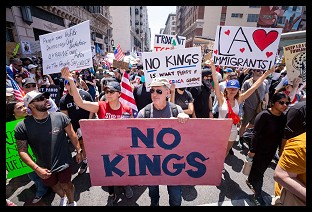 With Thanks, No Kings and Good Cheer
With Thanks, No Kings and Good Cheer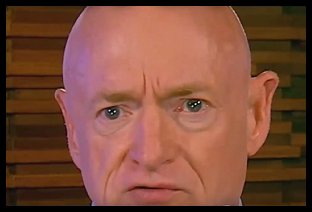 Presidential Illegality and the Duty to Disobey
Presidential Illegality and the Duty to Disobey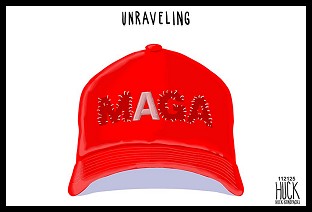 Sunday 'Leave 'em in Stitches' Toons
Sunday 'Leave 'em in Stitches' Toons President of United States Calls for Killing Democratic Officials: 'BradCast' 11/20/25
President of United States Calls for Killing Democratic Officials: 'BradCast' 11/20/25 'Green News Report' 11/20/25
'Green News Report' 11/20/25
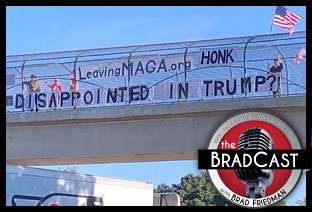 Is MAGA Finally Beginning to Fall Apart?: 'BradCast' 11/19/25
Is MAGA Finally Beginning to Fall Apart?: 'BradCast' 11/19/25 Trump's Terrible, Horrible,
Trump's Terrible, Horrible, 'Green News Report' 11/18/25
'Green News Report' 11/18/25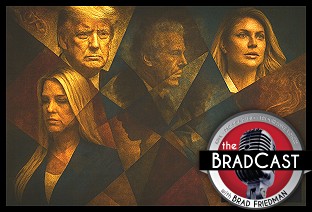 A Kaleidoscope of Trump Corruption: 'BradCast' 11/17/25
A Kaleidoscope of Trump Corruption: 'BradCast' 11/17/25 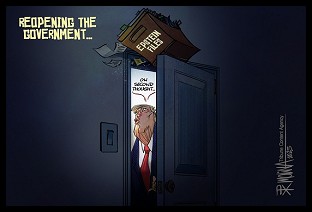 Sunday 'Back to Business' Toons
Sunday 'Back to Business' Toons Trump DOJ Takes Stand
Trump DOJ Takes Stand 'Green News Report' 11/13/25
'Green News Report' 11/13/25 Mamdani's 'Surprisingly Affordable' Afford-ability Agenda for NYC: 'BradCast' 11/12
Mamdani's 'Surprisingly Affordable' Afford-ability Agenda for NYC: 'BradCast' 11/12 After the Shutdown and Before the Next One: 'BradCast' 11/11/25
After the Shutdown and Before the Next One: 'BradCast' 11/11/25 'Green News Report' 11/11/25
'Green News Report' 11/11/25 Victories for Democracy in Election 2025; Also: 7 Dems, 1 Indie Vote to End Shutdown in Senate: 'BradCast' 11/10/25
Victories for Democracy in Election 2025; Also: 7 Dems, 1 Indie Vote to End Shutdown in Senate: 'BradCast' 11/10/25 Sunday 'Ass Kicking' Toons
Sunday 'Ass Kicking' Toons 'We Can See Light at the End of the Tunnel' After Election 2025: 'BradCast' 11/6/25
'We Can See Light at the End of the Tunnel' After Election 2025: 'BradCast' 11/6/25 'Green News Report' 11/6/25
'Green News Report' 11/6/25 BLUE WAVE! Dems Win Everything Everywhere All at Once: 'BradCast' 11/5/25
BLUE WAVE! Dems Win Everything Everywhere All at Once: 'BradCast' 11/5/25 Repub Thuggery As Americans Vote: 'BradCast' 11/4/25
Repub Thuggery As Americans Vote: 'BradCast' 11/4/25 Last Call(s) Before Election Day 2025: 'BradCast' 11/3/25
Last Call(s) Before Election Day 2025: 'BradCast' 11/3/25 A Pretty Weak 'Strongman': 'BradCast' 10/30/25
A Pretty Weak 'Strongman': 'BradCast' 10/30/25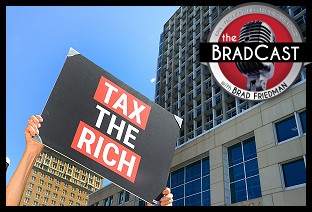 Proposal for 'Politically Viable Wealth Tax' Takes Shape in CA: 'BradCast' 10/29
Proposal for 'Politically Viable Wealth Tax' Takes Shape in CA: 'BradCast' 10/29 Monster Storm, Endless Wars, Gamed Elections: 'BradCast' 10/28/25
Monster Storm, Endless Wars, Gamed Elections: 'BradCast' 10/28/25 Let's Play 'Who Wants to Be a U.S. Citizen?'!: 'BradCast' 10/27/25
Let's Play 'Who Wants to Be a U.S. Citizen?'!: 'BradCast' 10/27/25 Exiled NOAA Scientists Resurrect Critical Disaster Database: 'BradCast' 10/23/25
Exiled NOAA Scientists Resurrect Critical Disaster Database: 'BradCast' 10/23/25
 VA GOP VOTER REG FRAUDSTER OFF HOOK
VA GOP VOTER REG FRAUDSTER OFF HOOK Criminal GOP Voter Registration Fraud Probe Expanding in VA
Criminal GOP Voter Registration Fraud Probe Expanding in VA DOJ PROBE SOUGHT AFTER VA ARREST
DOJ PROBE SOUGHT AFTER VA ARREST Arrest in VA: GOP Voter Reg Scandal Widens
Arrest in VA: GOP Voter Reg Scandal Widens ALL TOGETHER: ROVE, SPROUL, KOCHS, RNC
ALL TOGETHER: ROVE, SPROUL, KOCHS, RNC LATimes: RNC's 'Fired' Sproul Working for Repubs in 'as Many as 30 States'
LATimes: RNC's 'Fired' Sproul Working for Repubs in 'as Many as 30 States' 'Fired' Sproul Group 'Cloned', Still Working for Republicans in At Least 10 States
'Fired' Sproul Group 'Cloned', Still Working for Republicans in At Least 10 States FINALLY: FOX ON GOP REG FRAUD SCANDAL
FINALLY: FOX ON GOP REG FRAUD SCANDAL COLORADO FOLLOWS FLORIDA WITH GOP CRIMINAL INVESTIGATION
COLORADO FOLLOWS FLORIDA WITH GOP CRIMINAL INVESTIGATION CRIMINAL PROBE LAUNCHED INTO GOP VOTER REGISTRATION FRAUD SCANDAL IN FL
CRIMINAL PROBE LAUNCHED INTO GOP VOTER REGISTRATION FRAUD SCANDAL IN FL Brad Breaks PA Photo ID & GOP Registration Fraud Scandal News on Hartmann TV
Brad Breaks PA Photo ID & GOP Registration Fraud Scandal News on Hartmann TV  CAUGHT ON TAPE: COORDINATED NATIONWIDE GOP VOTER REG SCAM
CAUGHT ON TAPE: COORDINATED NATIONWIDE GOP VOTER REG SCAM CRIMINAL ELECTION FRAUD COMPLAINT FILED AGAINST GOP 'FRAUD' FIRM
CRIMINAL ELECTION FRAUD COMPLAINT FILED AGAINST GOP 'FRAUD' FIRM RICK SCOTT GETS ROLLED IN GOP REGISTRATION FRAUD SCANDAL
RICK SCOTT GETS ROLLED IN GOP REGISTRATION FRAUD SCANDAL VIDEO: Brad Breaks GOP Reg Fraud Scandal on Hartmann TV
VIDEO: Brad Breaks GOP Reg Fraud Scandal on Hartmann TV RNC FIRES NATIONAL VOTER REGISTRATION FIRM FOR FRAUD
RNC FIRES NATIONAL VOTER REGISTRATION FIRM FOR FRAUD EXCLUSIVE: Intvw w/ FL Official Who First Discovered GOP Reg Fraud
EXCLUSIVE: Intvw w/ FL Official Who First Discovered GOP Reg Fraud GOP REGISTRATION FRAUD FOUND IN FL
GOP REGISTRATION FRAUD FOUND IN FL

































